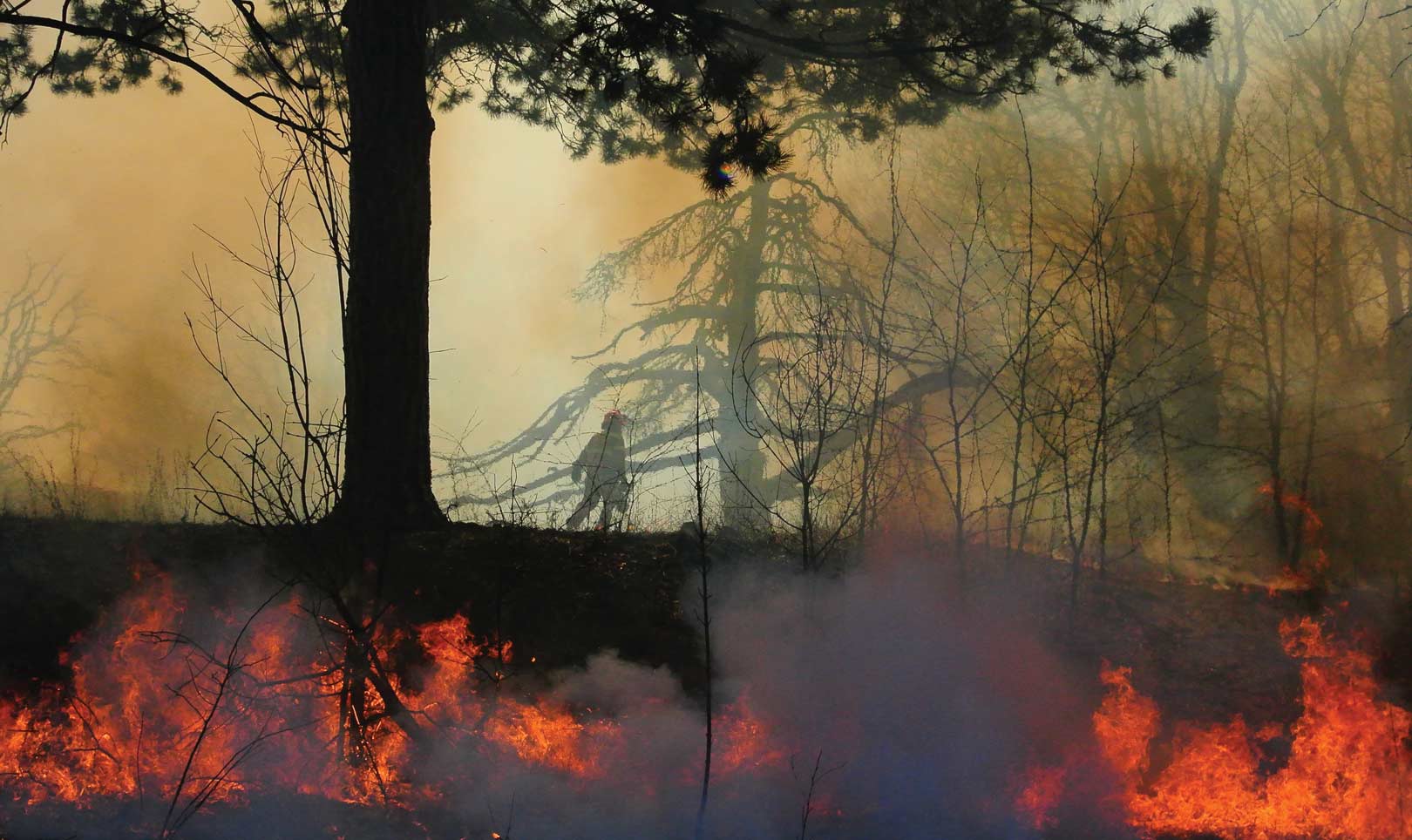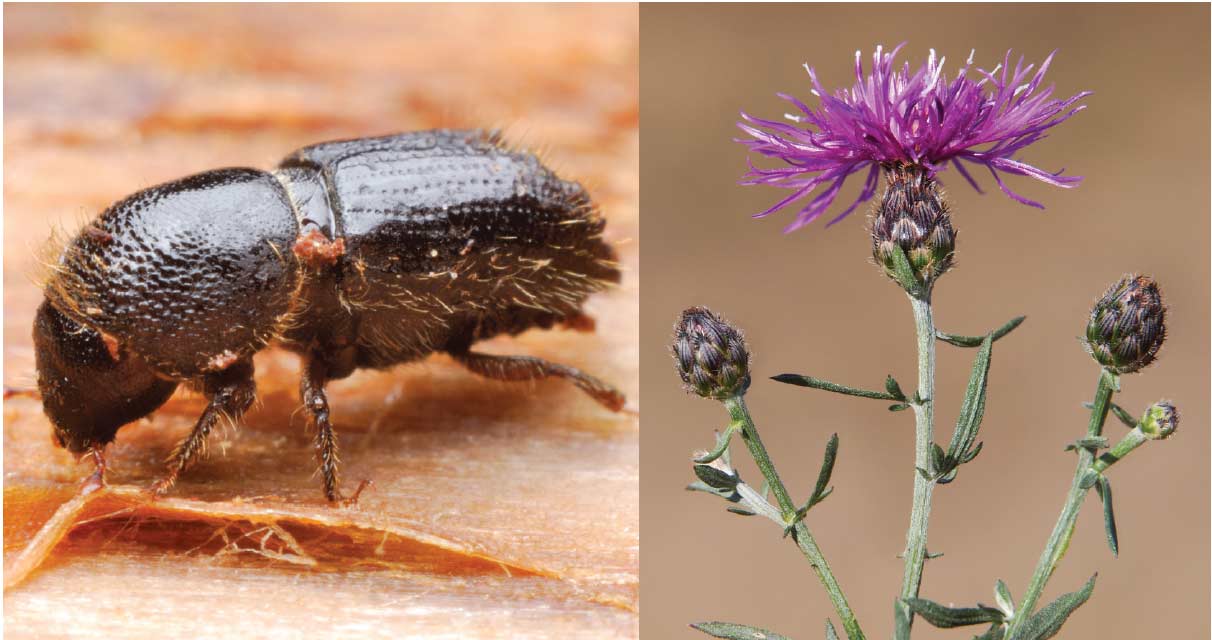

Prescribed burns help control invasive species like bark beetle and the spotted knapweed.

left to right: Prescribed burn at Alderville Black Oak Savanna; and at ‘Stream to Shore’ restoration site, near Sandercock Creek
The acrid smell of smoke, orange-coloured skies and daily air quality updates defined the summer we have just experienced. Hot temperatures and periods of drought that caused multiple fires in Ontario and neighbouring Quebec marked a climate trend that threatens to extend future fire seasons in both length and scope. In response, local conservation authorities, municipalities and firefighters are teaming up to protect and restore our forests by employing one of the best strategies they have – they are starting fires of their own.
“Prescribed burns are a key conservation and hazard reduction tool that supports the restoration and growth of native habitats and protects the forest. [They] help to reduce the risk of wildfire by limiting the amount of flammable vegetation in the area,” says County of Northumberland Natural Heritage Manager, Todd Farrell.
You heard correctly. Fighting fire with fire is a real thing. This strategy seems to go against everything that Smokey the Bear taught us, but prescribed burns are undertaken in our local forests every few years.
The idea is that by burning the forest undergrowth, you eliminate debris that “fuels” fires and therefore contain the fire in a limited area until it naturally burns itself out. An added benefit is that nitrogen and other nutrients, previously trapped in decaying logs on the forest floor, are released back into the soil without affecting or damaging the deep roots of the trees.
The Alderville Black Oak Savanna, a First Nation governed not-for-profit, utilizes prescription burns to support endangered Tallgrass habitats that have coevolved with fire, and control the spread of invasive species such as spotted knapweed, European buckthorn and staghorn sumac. In large urban centres, fire services are also employing ground fires in city parks to fight another ecosystem disruptor.
“In Toronto’s High Park, burns are commonly used to fight infestations of wood-boring insects. We’re there to make sure that the fires don’t get out of control and jump to residential areas,” says Brian Porter, a Cobourg resident and Toronto Fire Services Captain.
Prescribed burns, controlling invasive species, and forest management are important measures in our efforts to make local forests less vulnerable to widespread forest fires, but Acting Deputy CAO, Fire Chief and CEMC for Alnwick/Haldimand Fire Rescue Dave Dawson (whose response area includes communities like Roseneath and Grafton) offers insight into some overlooked, but important, preventive measures.
“Most fires are caused by careless behaviour,” he says. “We need people to be aware of the consequences of their actions, because although we have a group of dedicated local firefighters, the majority are volunteers who are specialized in fighting residential fires, and not forest fires.”
Whereas most urban firefighting requires large amounts of water to extinguish residential fires, wildfires are often in remote areas, on uneven terrain with limited access to water. Both types of firefighting are dangerous, and these days they share a sobering commonality: there are not enough firefighters to meet the demand.
Municipalities are depending more and more on well-trained volunteer firefighters for urban firefighting, and international fire teams are increasingly called in to help fire crews with forest fires in areas like Northern Ontario.
With the exception of Belleville and Cobourg, local volunteer firefighters outnumber the full-time staff, and even though volunteers are now being paid, some fire chiefs worry that new requirements may discourage future recruits.
Chief Dawson explains: “Volunteer firefighters in our municipalities are compensated for attending training, emergencies and station duties, but the challenge is finding people that are willing to undergo the longer certification process, with courses that sometimes run over seven to ten weekends.”
This past June JP Hornick, Ontario Public Service Employees Union (OPSEU) president, told CBC News the province was short 50 crews for this fire season. The preventive work that used to be conducted in the non-fire season – such as prescribed burns – is not happening to the same extent, leaving our forests more vulnerable.
The question arises: why can’t the province attract skilled firefighters to meet the demand? Perhaps the answer lies in compensation. A recent Ontario Public Service job posting shows the starting salaries for qualified wildfire fighters range from $22.89 to $29.86 per hour, perhaps not enough for a job involving gruelling work away from family for three months, long hours and dangerous conditions. On top of that, provincial spending cuts have meant that municipalities are forced to offer seasonal contracts instead of full-time positions to fire rangers. This has deterred new recruits wanting full-time employment from entering the field. Not only is this bad news for fighting forest fires, but also for fire prevention.
To meet these challenges, municipalities like Prince Edward County are hoping to spark new interest in volunteer firefighting with campaigns like “Answer the Call” – and taglines like “Being a volunteer firefighter isn’t something you do; it’s something you are.”
Municipalities are depending more and more on well-trained volunteer firefighters and international fire teams are increasingly called in to help fire crews with forest fires in areas like Northern Ontario.
In July, Belleville Fire and Emergency Services partnered up with Quinte West Fire Rescue and the Hastings & Prince Edward Training Centre to operate Camp Molly (inspired by Molly Williams, the first female firefighter on record in North America), a three-day program that aims to encourage young women between 15 and 18 to consider a career in firefighting.
For the majority of us who want to prevent another smoky fire season from blotting out our green landscapes, Chief Dawson recommends that we take note of local burning bans and use common sense: “If you are starting a campfire, make sure that the area is away from dry grasses and always have a bucket of water or necessary materials to extinguish a fire.”
Local conservation authorities also recommend more preventive forest management plans to reduce the risk of high-intensity fires; clearing away the dried grasses, brush and other organic material that can fuel a fire; and practising my friend’s dad’s favourite pastime – “tidying up the forest,” by picking up fallen branches.
Smokey’s message – nearly 80 years old now – still resonates today: “Only you can prevent forest fires.”
Story by:
Micol Marotti
Photography by:
Irene Wilk




